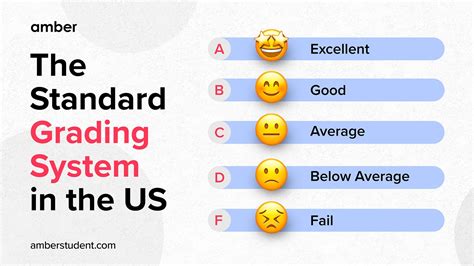The United States uses a letter grading system to assess academic performance. This system assigns grades from A to F, with A being the highest and F being the lowest. Each grade corresponds to a percentage range:

| Grade | Percentage Range |
|---|---|
| A | 90% – 100% |
| B | 80% – 89% |
| C | 70% – 79% |
| D | 60% – 69% |
| F | 0% – 59% |
Grading typically involves assessing student work based on criteria established in advance. These criteria may include:
- Knowledge and Understanding: Demonstrating a grasp of course material and concepts.
- Application: Applying knowledge and skills to solve problems, analyze information, or create new ideas.
- Critical Thinking: Evaluating and interpreting information, making inferences, and drawing conclusions.
- Communication: Communicating knowledge, ideas, and opinions effectively in writing, speaking, or presentation form.
- Effort and Participation: Contributing to class discussions, completing assignments on time, and participating actively.
In addition to the traditional letter grading system, there are other types of grading systems used in the United States:
- Pass/Fail: Students receive either a “pass” or “fail” grade, typically based on meeting a minimum threshold.
- Satisfactory/Unsatisfactory: Similar to pass/fail, but with more gradations, such as “low satisfactory” or “high satisfactory.”
- Credit/No Credit: Students receive a “credit” for successfully completing a course, regardless of their final grade.
- Norm-Referenced Grading: Students are compared to each other, with a certain percentage earning A’s, B’s, etc.
- Criterion-Referenced Grading: Students are assessed against specific criteria or standards, without comparison to others.
The American grading system provides several benefits:
- Objective Measurement: Grades allow for a relatively objective measure of student achievement, which can be used for evaluation, placement, and decision-making.
- Motivator: Grades can motivate students to work hard and achieve academic goals.
- Feedback: Grades provide feedback to students on their progress and areas for improvement.
- Standardization: The system provides a standardized way of evaluating student performance across different schools and institutions.
The American grading system has also faced criticism:
- Subjectivity: Grading can be subjective, influenced by teacher bias, grading rubrics, or the quality of student work.
- Pressure: Grades can create undue pressure and anxiety for students, leading to stress and burnout.
- Competition: The system can promote competition among students, which may not be healthy or beneficial.
- Lack of Feedback: Grades often provide limited feedback on student performance, making it difficult for students to improve.
- Standardization Issues: The system may stifle student creativity and discourage original thinking, as students focus on meeting grading criteria.
To improve the American grading system, consider these tips:
- Use a Variety of Assessment Methods: Use multiple assessment methods to provide a more comprehensive evaluation of student learning.
- Provide Constructive Feedback: Focus on providing specific and actionable feedback to help students improve.
- Consider Different Grading Scales: Explore alternative grading scales that provide more flexibility and differentiation.
- Empower Students: Involve students in developing grading criteria and assessing their own work.
- Address Subjectivity: Establish clear grading rubrics and engage in peer review or external moderation to reduce bias.
- Promote Growth Mindset: Encourage students to view grades as opportunities for growth and improvement rather than fixed measures of ability.
The American grading system is evolving to meet the changing needs of students and educators. Some emerging trends include:
- Personalized Grading: Tailoring grading to individual student needs and learning styles.
- Competency-Based Grading: Assessing students’ mastery of specific skills and knowledge without relying on traditional letter grades.
- Technology-Enhanced Grading: Using technology to automate grading processes, provide instant feedback, and personalize assessments.
The American grading system is a complex and evolving approach to assessing student performance. While it provides several benefits, it also faces challenges related to subjectivity, pressure, and lack of feedback. By understanding its strengths and limitations, educators can work to improve the system and ensure that grades are used to support student growth, motivation, and learning.
